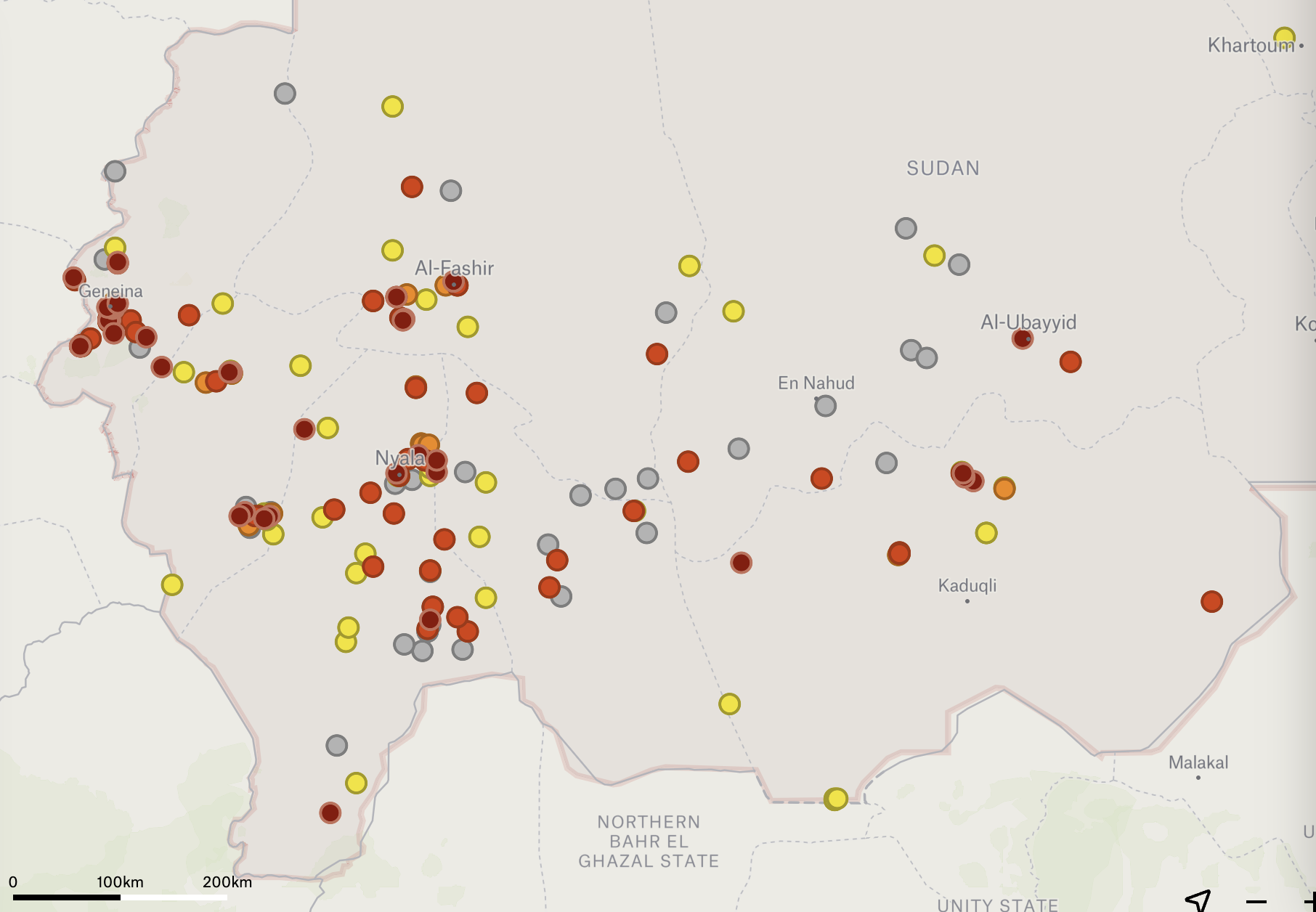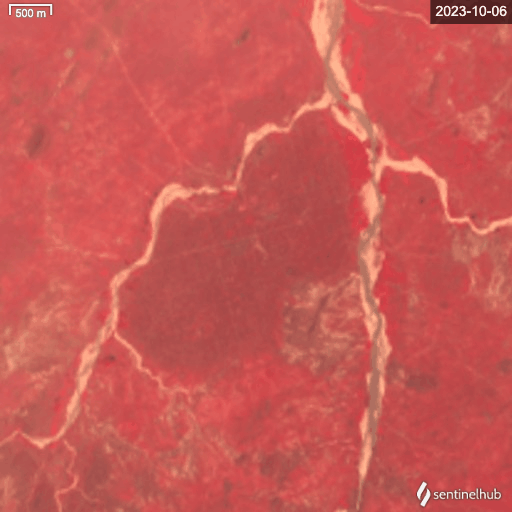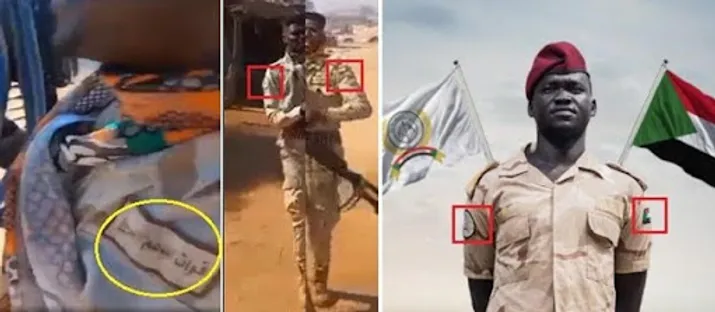
At least 108 villages and settlements have been partially or completely destroyed by fire since the start of the civil war in Sudan last April, according to open source analysis carried out by CIR’s Sudan Witness project.
Sudan Witness investigators used satellite imagery, publicly available fire monitoring data from NASA, and social media content to investigate and assess patterns of fires in Darfur and other regions of Sudan.
Investigators documented at least 180 fire incidents, located mostly in Darfur, between the outbreak of violence in April 2023 and the end of February 2024.
The International Organization for Migration (IOM) estimates that 7.1 million people are displaced in Sudan, 4.5 million of whom have been displaced since the conflict erupted nearly a year ago. The Darfur region is frequently cited as having the highest proportion of displaced people.
Renewed and repeated fires
The analysis carried out by Sudan Witness reveals that some villages have been burnt more than once, that camps for displaced people have been burnt leading to people being forced to flee twice, and that villages in close proximity to each other have been set ablaze in the same period.
In Misterei, West Darfur, fires occurred in two phases, first in May to June last year, then again between October 2023 and March this year. Sudan Witness found that residential areas in the town were set alight at intervals of multiple days in what appear to be systematic burnings based along the lines of the town’s grid street plan.

Timelapse created with Sentinel-2 satellite imagery of Misterei, created with imagery from 6 October 2023 until 9 March 2024 highlighting fire damage. Credit: Copernicus Sentinel-2/US Geological Survey Landsat, processed with EO Browser
While the town had already been severely damaged last year, investigators estimated that more than half of Misterei was damaged by fire between 11 and 31 October, with additional areas burnt in subsequent months.
Anouk Theunissen, Sudan Witness team leader, said:
“Through open source analysis, we’ve documented the patterns of numerous fires in Sudan and the widespread devastation they cause. Since the conflict broke out last April, fire appears to have become a weapon of war, leading to mass displacement. We’ve seen over one hundred villages damaged or destroyed by fire, some on more than one occasion.
“In towns such as Misterei, near the Chad border and home to tens of thousands of people, we’ve seen renewed fires in recent months, with whole swathes of the town burnt just days apart in some of the worst damage we’ve witnessed. Such destruction has forced many to leave their homes and livelihoods and has left those who remain living in fear.”
“In several cases, social media videos show armed militia near the fires, or fighters on motorbikes passing market stalls and dwellings as they burn. At a time when journalists face limited access to Sudan, open source plays a critical role in showing the world what’s happening – and in ensuring there’s an archive of verified data to support justice and accountability efforts in the future.”
Claims of airstrikes and inter-communal clashes
When verifying fire incidents, Sudan Witness analyses user-generated content uploaded to social media and cross-references footage with satellite sources to identify heat signatures and visible damage.
In some cases, fire incidents verified by Sudan Witness have coincided with claims of reported airstrikes by the Sudanese military, with investigators identifying damage consistent with shrapnel impact and bomb craters in East and North Darfur earlier this year.
Videos collected and verified by Sudan Witness in August and September 2023 were linked to inter-communal clashes in the Kubum and Mukjar localities, near the border of South and Central Darfur, which reportedly led to large numbers of deaths on both sides, the displacement of thousands of civilians, and multiple villages burnt.
While it is not possible to be definitive, the data collected by Sudan Witness appears to show a shift in trend occurring in late 2023 and early 2024, with more fire incidents starting to appear in Kordofan, to the east of Darfur, since that time. In footage of burning buildings geolocated to Al Takma, South Kordofan, in December 2023, several men can be seen wearing RSF uniforms.

Al Takma, South Kordofan: A Rapid Support Forces tag on the front of a uniform seen in the footage (left, circled) and RSF patches identified on the arms of the uniform also seen on the RSF X (formerly Twitter) page (middle and right) Sources: X (formerly Twitter)
Documenting the destruction
In October last year, Sudan Witness published its map documenting verified information on fires in Sudan. At the time, the data revealed that 68 villages in Darfur had been set on fire, prompting the UK Minister for Development and Africa, Andrew Mitchell, to warn that the reported targeting and mass displacement of the Masalit community in Darfur bore “all the hallmarks of ethnic cleansing”.
The map assigns different levels of confidence to fire incidents that have occurred based on the sources of data available. The conclusion about the total number of fires and villages damaged is based on those fires given a medium to very high level of confidence. Alongside the confidence level of open source verification, the methodology tries to identify and rule out false positives and accidental fires, but ultimately a margin of error remains and the conclusions drawn cannot be completely definitive.
In collaboration with C4ADS and the Sudan Human Rights Hub, Sudan Witness also contributes towards the Sudan Shahid map, which was set up following the outbreak of violence in April 2023 to collect, monitor and analyse a wide range of data relating to human rights abuses.
لقراءة المقال بالعربية

